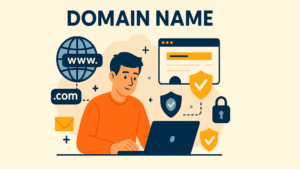
A Content Security Policy (CSP) is a powerful browser-side security layer that helps prevent attacks like JavaScript injection, clickjacking, and code manipulation. Acting as a digital firewall inside the browser, CSP controls which resources are allowed to load and execute on a webpage. This modern web standard gives site operators precise control over the scripts, styles and third-party services their web pages trust and blocks everything else.
By defining an allowlist of trusted sources, CSP significantly reduces the risk of cross-site scripting (XSS) and other injection attacks, making it an essential part of any application’s web security strategy.
Table of contents
How Content Security Policy Works in the Browser
CSP is delivered to the browser via the Content-Security-Policy HTTP response header. This header contains one or more directives, each specifying rules for different resource types: scripts, stylesheets, images, fonts, frames, etc.
For example, a policy might only allow content from your own domain, specific trusted script sources, and explicitly block the embedding of your pages in iframes. By restricting where content can be loaded from, CSP blocks unauthorized scripts, stops attackers from injecting malicious payloads, and enforces secure coding practices.
Why CSP Matters: Real Threats It Blocks
Website owners most commonly use CSP to block cross-site scripting (XSS) attacks. When a vulnerability allows attackers to inject malicious JavaScript, CSP stops the browser from executing the script unless it comes from an approved source.
CSP prevents attackers from loading your site inside hidden frames on their own pages, a common clickjacking technique. By explicitly controlling which websites may embed your content, you block these deceptive setups and stop attackers from tricking users into clicking on disguised elements.
In addition, CSP helps enforce HTTPS across your entire site by automatically upgrading resource requests from HTTP to secure HTTPS, helping maintain a consistent security posture.
CSP and Secure Development Practices
CSP supports industry standards and compliance requirements like PCI DSS 4.0 and GDPR. It provides effective protection against zero-day script injection threats and adds an extra layer of control to modern web development practices. For seamless compatibility, captcha.eu offers CSP-ready CAPTCHA integration. See the full captcha.eu CSP documentation for guidance.
Common CSP Challenges and How to Address Them
Inline scripts and styles pose a challenge because CSP blocks them by default. This forces developers to rethink how scripts are added to the page. Instead of allowing unsafe-inline scripts, the recommended approach is to use nonces or hashes.
A nonce is a unique, random value generated on the server that must match in both the CSP header and the corresponding <script> or <style> tag. Alternatively, hashes allow you to specify the exact content that’s permitted to run. Both techniques strengthen security without sacrificing flexibility.
To ensure a smooth rollout, start by running your policy in report-only mode using the Content-Security-Policy-Report-Only header. This approach allows you to monitor which resources would be blocked, without affecting the user experience. It’s a smart way to fine-tune your policy and catch potential issues before full enforcement.
Troubleshooting CSP: How to Resolve Policy Errors
Even well-prepared policies may result in unexpected violations. If you encounter issues, the browser console provides detailed error messages that show exactly what resource was blocked and why.
For testing and debugging, captcha.eu offers a live CSP demo environment, where you can simulate how your policies interact with CAPTCHA features. If problems persist, consult the captcha.eu documentation or contact support with your error logs for tailored help.
Why CAPTCHA and CSP Work Hand in Hand
CSP restricts what scripts can run, but it doesn’t differentiate between humans and bots. That’s where CAPTCHA comes in. To prevent abuse of login forms, comment fields, and payment gateways, a CAPTCHA solution is essential.
captcha.eu’s GDPR-compliant CAPTCHA technology is fully compatible with strict CSP environments. It provides non-invasive user verification without compromising browser security. Together, CSP and CAPTCHA form a comprehensive protection model for modern websites.
Conclusion
CSP offers powerful defenses against injected scripts and unauthorized content loading. It secures user sessions, supports privacy compliance, and reduces your attack surface, all from within the browser.
When you combine CSP with bot detection and human verification tools like captcha.eu, you strengthen your defense against both browser-based threats and automated attacks. Whether you’re building or securing a web platform, make CSP one of your first lines of defense, implement it thoughtfully, test it thoroughly and maintain it continuously.
FAQ – Frequently Asked Questions
What is Content Security Policy (CSP)?
CSP is a security standard that helps prevent attacks like cross-site scripting (XSS), clickjacking, and malicious code injection by controlling which resources a browser is allowed to load and execute on a website.
Why is CSP important for website security?
CSP acts as a browser-side firewall, reducing the risk of client-side attacks. It enforces strict rules for loading scripts, images, and other resources, protecting users and sensitive data.
How does CSP prevent XSS attacks?
CSP blocks execution of unauthorized scripts by only allowing JavaScript from trusted sources. This stops attackers from injecting and running malicious code via user input or vulnerable third-party scripts.
What are CSP directives?
CSP directives are specific rules that define allowed content sources. Common directives include default-src, script-src, img-src, and frame-ancestors, each controlling different types of content.
What is CSP Report-Only mode?
Report-Only mode lets developers test a CSP policy without enforcing it. The browser logs violations, helping site owners fine-tune their policies before full deployment without breaking functionality.
100 free requests
You have the opportunity to test and try our product with 100 free requests.
If you have any questions
Contact us
Our support team is available to assist you.




